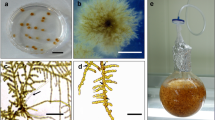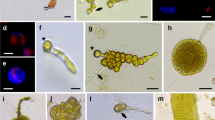Abstract
Gracilariopsis lemaneiformis is a commercially exploited alga. Its filaceous thallus can be divided into three parts, holdfast, middle segment and tip. The growth and branch forming trend and agar content of these three parts were analyzed, respectively, in this study. The results showed that the tip had the highest growth rate and branched most, although it was the last part with branch forming ability. The holdfast formed branches earliest but slowly. Holdfast had the highest agar content. We also assessed the difference in protoplast formation and regeneration among three parts. The middle segment displayed the shortest enzymolysis time and the highest protoplast yield; whereas the tip had the strongest vitality of protoplasts formation. Juvenile plants were only obtained from the protoplasts generated from the tip. These results suggested that the differentiation and function of G. lemaneiformis was different.
Similar content being viewed by others
References
Armisen, R., 1995. World-wide use and importance of Gracilaria. Journal of Applied Phycology, 7: 231–243.
Chen, W. Z., Xu, D., Wang, L. G., Meng, L., Du, H., and Zhang, X. C., 2009. Preliminary study on economic characteristics and agar characteristics of two new strains of Gracilaria lemaneiformis. Periodical of Ocean University of China, 39(3): 437–442 (in Chinese with English abstract).
Chen, X. F., Yang, X. Q., Qi, B., Li, L. H., Chen, S. J., and Hao, S. X., 2011. Preparation of dietary fiber from Gracilaria lemaneiformis by fermentation. Food Science, 32(18): 112–116.
Chu, J. S., Liu, W. S., and Zhang, Z. Y., 1998. A preliminary study on the isolation and cultivation of protoplasts from G. Verrucosa. Marine Science Bulletin, 17(6): 17–20.
Li, H. Y., Huang, J. Y., Xin, Y. J., Zhang, B. M., Jin, Y., and Zhang, W., 2009. Optimization and scale-up of a new photobleaching agar extraction process from Gracilaria lemaneiformis. Journal of Applied Phycology, 21: 247–254.
Li, M., Sui, Z. H., Kang, K. H., Zhang, X. C., Zhu, M., and Yan, B. L., 2010. Cloning and analysis of the galactose-1-phosphate uridylyltransferase (galt) gene of Gracilariopsis lemaneiformis (Rhodophyta) and correlation between gene expression and agar synthesis. Journal of Applied Phycology, 22(2): 157–164.
Liu, C. S., Liu, C. G., Meng, X. H., He, J., and Liu, W. S., 2002. Preparation and characteristics of snail enzymes. Journal of Wuhan University (Natural Science Edition), 48(2): 243–248.
Liu, C. Y., and Sun, X. Q., 2007. The biological effects and application prospects of Gracilariopsis lemaneiformis. Animals Breeding and Feed, 5: 55–58.
Liu, W. S., Tang, Y. L., Liu, X. W., and Fang, T. C., 1984. Studies on the preparation and on the properties of sea snail enzymes. Hydrobiologia, 116/117: 319–320.
Marinho-Soriano, E., 2001. Agar polysaccharides from Gracilaria species (Rhodophyta, Gracilariaceae). Journal of Biotechnology, 89(1): 81–84.
Mollet, I. C., Verdus, M. C., Kling, R., and Morvan, H., 1995. Improved protoplast yield and cell wall regeneration in Gracilaria verrucosa (Huds.) Papenfuss (Gracilariales, Rhodophyta). Journal of Experimental Botany, 46(2): 239–247.
Pang, Q. Q., Sui, Z. H., Kang, K. H., Kong, F. N., and Zhang, X. C., 2010. Application of SSR and AFLP to the analysis of genetic diversity in Gracilariopsis lemaneiformis (Rhodophyta). Journal of Applied Phycology, 22(5): 607–612.
Patwary, M. U., and van der Meer, J. P., 1992. Genetics and breeding of cultivated seaweeds. Korean Journal of Physiology & Pharmacology, 7(2): 281–318.
Pei, J. C., Lin, A., Zhang, F. D., Zhu, D. L., Li, J., and Wang, G. C., 2012. Using agar extraction waste of Gracilaria lemaneiformis in the papermaking industry. Journal of Applied Phycology, DOI: 10.1007/s10811-012-9929-7.
Provasoli, L., 1968. Media and prospect for the cultication of marine algae. In: Proceedings of the U.S.-Japan Conference held at Hakone, September 12–15, 1966. Watannbe and Hattori, eds., Japan Society of Plant Physiologists, 63–75.
Rüchel, R., Dellmann, A., Schaffrinski, M., and Donhuijsen, K., 2004. Fungus detection-A simple method. Screening with optical brighteners. Pathologe, 25(3): 235–237.
Wang, S. J., Zhang, X. P., Xu, Z. D., and Sun, Y. L., 1986. A study on the cultivation of the vegetative cells and protoplasts of P. haitanensis I. Oceanologia Et Limnologia Sinica, 17(3): 217–221.
Xiao, Z. A., 2005. Plant Biotechnology. Chemical Industry Press, Beijing, 122–123 (in Chinese).
Xu, J. T., and Gao, K. S., 2008. Growth, pigments, UV-absorbing compounds and agar yield of the economic red seaweed Gracilaria lemaneiformis (Rhodophyta) grown at different depths in the coastal waters of the South China Sea. Journal of Applied Phycology, 20: 681–686.
Xu, X. H., Wang, P., and Zhao, S. Z., 2007. Study on the tool enzymes of isolating protoplasts of Porphyra yezoensis. Journal of Huaihai Institute Technology (Natural Sciences Edition), 16(3): 66–69.
Xue, Z. X., Yang, G. P., and Wang, G. C., 2006. Study on extraction method of agar from Gracilaria lemaneiformis. Marine Sciences, 30(8): 71–77.
Yang, B. Y., Shen, Q. H., Xu, M., Yang, N. S., and Zhong, Q. P., 1996. Study on protoplast isolation of Cymbidium faberi. Acta Agriculturae Jiangxi, 8(2): 108–113.
Yang, Y. F., Fei, X. G., Song, J. M., Hu, H. Y., Wang, G. C., and Chung, I. K., 2006. Growth of Gracilaria lemaneiformis under different cultivation conditions and its effects on nutrient removal in Chinese coastal waters. Aquaculture, 254: 248–255.
Yeong, H. Y., Khalid, N., and Phang, S. M., 2007. Protoplast isolation and regeneration from Gracilaria changii (Gracilariales Rhodophyta). Journal of Applied Phycology, 20(5): 191–201.
Zhang, L. Y., Liu, N., and Sun, L. B., 2005a. Modern Environmental Microbial Technology. Tsinghua University Press, Beijing, 58pp (in Chinese).
Zhang, X. C., Qin, S., Ma, J. H., and Xu, P., 2005b. The Genetics of Marine Algae. Agriculture Press of China, Beijing, 239–240.
Zhang, L., Wang, X., Qian, H., Chi, S., Liu, C., and Liu, T., 2012. Complete sequences of the mitochondrial DNA of the wild Gracilariopsis lemaneiformis and two mutagenic cultivated breeds (Gracilariaceae, Rhodophyta). Plos One, 7(6): e40241.
Zhao, C., Sun, Y., Yi, Z. C., Rong, L., Zhuang, F. Y., and Fan, Y. B., 2010. Simulated microgravity inhibits cell wall regeneration of Penicillium decumbens protoplasts. Advances in Space Research, 46(6): 701–706.
Author information
Authors and Affiliations
Corresponding author
Rights and permissions
About this article
Cite this article
Wang, Z., Sui, Z., Hu, Y. et al. A comparison of different Gracilariopsis lemaneiformis (Rhodophyta) parts in biochemical characteristics, protoplast formation and regeneration. J. Ocean Univ. China 13, 671–676 (2014). https://doi.org/10.1007/s11802-014-2217-1
Received:
Revised:
Accepted:
Published:
Issue Date:
DOI: https://doi.org/10.1007/s11802-014-2217-1




